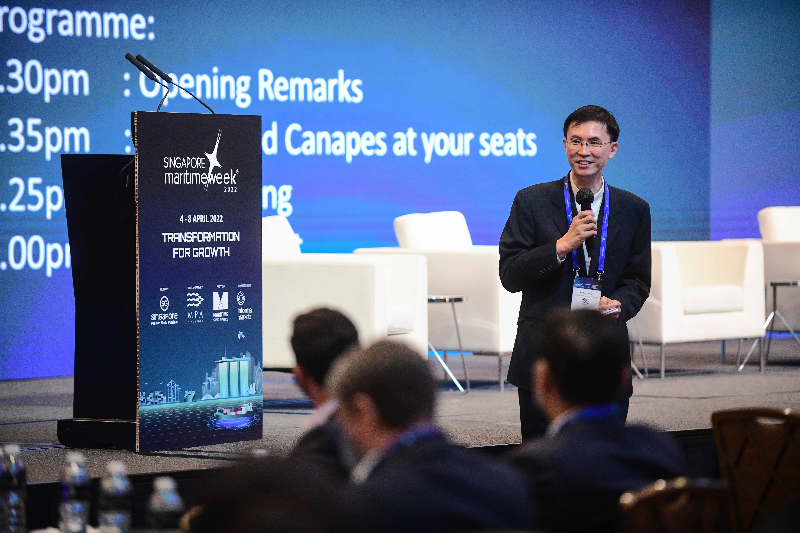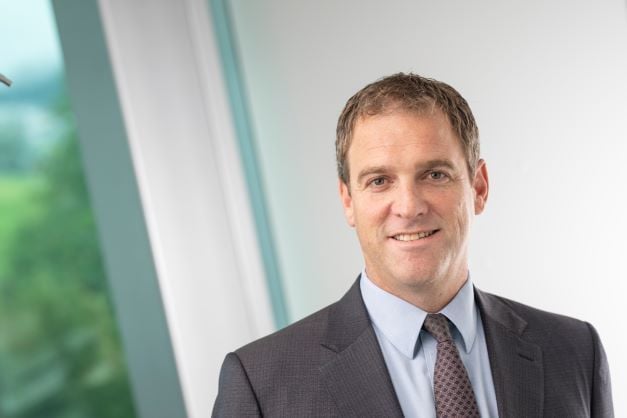Kenneth Lim: Heavy hitter
The Port of Singapore has cemented its position as a key maritime hub, leading the charge on decarbonisation, digitalisation and supply chain resilience. Kenneth Lim, Assistant CEO, Maritime and Port Authority of Singapore (MPA) tells ICS about the factors contributing to its ongoing success.

How successful were the MPA’s interventions during the pandemic, and how are you continuing to improve resilience to potential supply chain issues in future?
Our maritime hub was resilient and performed well through the pandemic. In 2022, we achieved our second highest container throughput of 37.3 million twenty-foot equivalent units (TEUs), remained the world’s largest transhipment hub, and retained our position as the world’s largest bunkering hub.
Recognising the critical role that seafarers play in keeping global supply chains open, MPA established the Shipping Tripartite Alliance Resilience Fund (STAR Fund) with Singapore Shipping Association (SSA), unions and international organisations to ensure that crew changes are conducted safely amongst seafaring nations. Our CrewSafe audit programme, with more than 40 accredited facilities in crew source nations, has provided quality control checks for crew change processes across quarantine, medical, and testing facilities for more than 280,000 crew changes to date.
Moving on from the pandemic, we must now work towards the next bound of growth amidst expectations of a global economic slowdown in 2023. We have identified four key focus areas: driving digitalisation, decarbonisation and alternative fuels, developing future-ready maritime talent and continuing collaboration.
Which of the many impressive planned developments to further Singapore’s competitiveness as a logistics and maritime knowledge hub are you most excited about?
As global demand for maritime trade is expected to grow, the deployment of the Next Generation Vessel Traffic Management System which incorporates Smart Collision Detection and Proactive Traffic Management, will be a key enabler to ensure continued safe and efficient shipping and port operations.
The rollout of digitalPORT@SG™ Phase 2 in 2023 includes modules for just-in-time vessel planning into terminals, one-stop access to marine services such as bunkering, supplies and repairs, as well as an Active Anchorage Management System to optimise the usage of anchorage spaces. This can significantly reduce ships’ turnaround time in port, as well as GHG emissions by minimising ships’ idling time at anchorages.
We are also looking forward to the establishment of three maritime 5G base stations by this year which will create the world’s first public and largest 5G maritime testbed for applications like remotely assisted pilotage advisory and delivery drones. Another goal is increasing the number of start-ups supported by MPA five-fold, from 30 in 2021 to 150 by 2025 via our Smart Port Challenge (SPC), run in partnership with the Port Innovation Ecosystem Reimagined at BLOCK71 (PIER71™). We have supported 50 start-up projects with grant funding of S$2.45 million so far.
In the energy transition, do you see MPA’s role as anticipating demand for clean fuels, or instead setting an agenda that ship operators can follow as they make their fuel choices?
Maritime Singapore is preparing itself for a multi-fuel future and we will need to work hand-in-hand with the industry to create pathways for alternative fuel. We have developed the world’s first marine biofuel provisional standard for biofuel blends up to 50% or B50. In 2022, 140,000 tonnes of biofuel blends were supplied across more than 90 biofuel bunkering operations. MPA will progressively update this standard to include B100, and this is expected to be completed by 2025. In parallel, we are also working with industries and various research entities on developing standards on bunkering for methanol and ammonia.
We are looking forward to receiving the submissions from the December 2022 Expression of Interest to build, own and operate low or zero-carbon ammonia power generation and bunkering solutions on Jurong Island. Given the toxicity of ammonia, effective incident and emergency response SOPs and systems to detect, respond, mitigate and recover from ammonia leakage incidents are critical for ammonia bunkering to be operationalised in port waters.
We have supported phase 2 of MESD’s Ammonia Safety Study, which will and assess the environmental impact of ammonia release, as well as characterise and recommend mitigation technologies, establish advanced modelling, and simulation capabilities for coupled near and far field ammonia dispersion in air and sea.
How could the shipping industry as a whole better prepare for the oncoming shift towards a resilient, decarbonised global logistics network?
Supply chains are becoming more complex as governments and companies around the world reconfigure their supply chains to enhance resilience. Singapore is focusing on four areas:
- Digitalisation: This will enable faster vessel clearance, enhance port efficiency, and reduce ship turnaround time. Not only will this help us cut down on delays in the logistics network, but it will also cut greenhouse gas emissions by minimising ship’s idling time at anchorages. Besides rolling out Phase 2 of digitalPORT@SG™ in 2023, we will also work with Singapore Trade Data Exchange (SGTraDex), Jurong Port and their partners to pilot a data sharing initiative that focuses on supplies procurement, fulfilment and lighterage logistics. This is in addition to initiatives that the MPA has previously rolled out including electronic bills of lading (EBL), digital bunkering (e.g. e-BDN) projects, and DigitalOceans to harmonise API/data standards and promote global data standards.
- Cybersecurity: As maritime systems become increasingly digitalised, the maritime industry must also be prepared with the right tools to manage the risk of cyber incidents that could disrupt the flow of vessels and cargo at our ports. We will establish the Maritime Cyber Assurance and Operations Centre (MCAOC) by 2025 to provide real-time security monitoring and dissemination of information to mitigate threats, advise on system recovery and measures to take following an incident, and facilitate cyber threat information-sharing among maritime stakeholders.
- Talent: The industry must also attract and develop a steady pipeline of maritime talent across all levels, who are equipped with the right skills and expertise as the industry transforms. Increasingly, this will also include skills and expertise in decarbonisation, digitalisation and cybersecurity. We offer internships, scholarships and pre-employment training as well as a career conversion programme for maritime and non-maritime talents – as well as our well-known Maritime Leadership Programme.
- Collaboration: A more resilient and decarbonised global logistics and shipping network can only take place when liked minded partners come together to raise the collaboration efforts between ports and shipowners/operators. We have just started the movement to bring together the collective resources and will of our partners through Green and Digital Shipping Corridors, and will continue to reach out and bring onboard all the stakeholders along the entire value chain to develop solutions, standards and enablers to facilitate efficient port calls, cargo flows, and paperless handling through the port of Singapore and partners.
What are the greatest misconceptions that shipowners have about Singapore ports and how would you like to redress them here?
The continued success of Singapore as a global transhipment hub did not simply happen by virtue of our strategic location. Over the last two years, COVID-19 and geopolitical tensions have caused supply chain disruptions that have resulted in reduced cargo throughput, port closures, and crew change challenges – which also affected us.
But Maritime Singapore came together- port operator PSA deployed more resources and manpower, and the strong tripartite partnership allowed Singapore to remain open and serve as a “catch-up” port for shipping lines. This was a partnership built over many years that is based on trust and a common sense of mission to ensure Singapore succeeds.
Our success was also enabled by a vibrant International Maritime Centre here in Singapore, which provides a very conducive business environment for shipping companies – and we have seen strong take up by local and international banks with shipping portfolios as well as the insurance sector, which was strengthened through the opening of the Swedish P&I Club in Singapore.
The Singapore Chamber of Maritime Arbitration (SCMA) continues to be integral in the global maritime arbitration landscape, particularly in Asia and there are currently about 30 leading shipbroking firms in Singapore – many of which are expanding.
We do not take for granted the success of both our ports and International Maritime Centre and will continue to strengthen our attractiveness and “stickiness” for shipping companies to set up and expand their business here.
Related content

Allard Castelein: Forging a path for future-proof ports

Bjørn Højgaard: Meeting challenge with flexibility and focus

David Cassidy: Practicality before perfection
